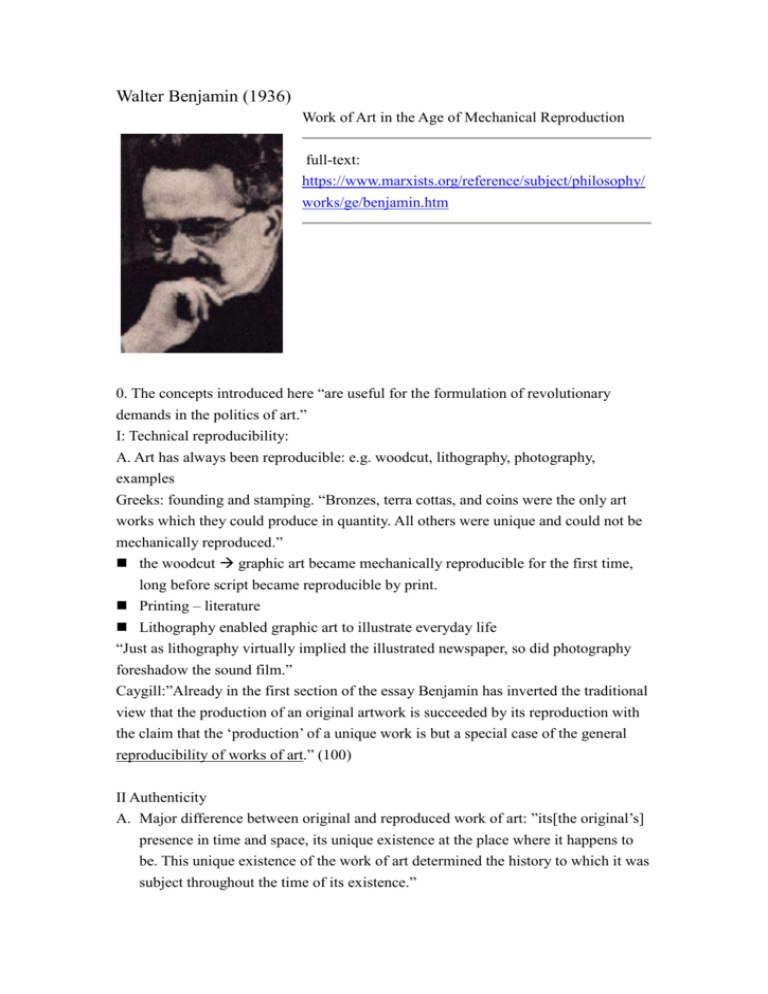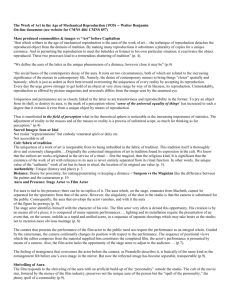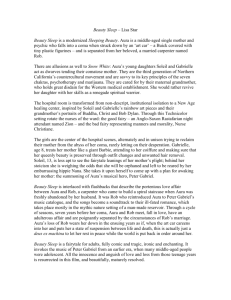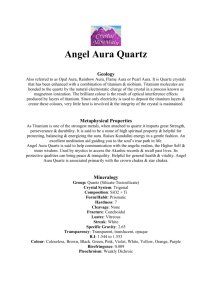Work of Art
advertisement

Walter Benjamin (1936) Work of Art in the Age of Mechanical Reproduction full-text: https://www.marxists.org/reference/subject/philosophy/ works/ge/benjamin.htm 0. The concepts introduced here “are useful for the formulation of revolutionary demands in the politics of art.” I: Technical reproducibility: A. Art has always been reproducible: e.g. woodcut, lithography, photography, examples Greeks: founding and stamping. “Bronzes, terra cottas, and coins were the only art works which they could produce in quantity. All others were unique and could not be mechanically reproduced.” the woodcut graphic art became mechanically reproducible for the first time, long before script became reproducible by print. Printing – literature Lithography enabled graphic art to illustrate everyday life “Just as lithography virtually implied the illustrated newspaper, so did photography foreshadow the sound film.” Caygill:”Already in the first section of the essay Benjamin has inverted the traditional view that the production of an original artwork is succeeded by its reproduction with the claim that the ‘production’ of a unique work is but a special case of the general reproducibility of works of art.” (100) II Authenticity A. Major difference between original and reproduced work of art: ”its[the original’s] presence in time and space, its unique existence at the place where it happens to be. This unique existence of the work of art determined the history to which it was subject throughout the time of its existence.” B. Authenticity: originality authenticity; “outside technical – and, of course, not only technical – reproducibility.” C. Not authentic, but autonomous from the original: 1) First, process reproduction is more independent of the original than manual reproduction. 2) Secondly, technical reproduction can put the copy of the original into situations which would be out of reach for the original itself. 3) meet the audience half way. D. Aura: reproducible art affects is the authority of the object. “One might subsume the eliminated element in the term “aura” and go on to say: that which withers in the age of mechanical reproduction is the aura of the work of art.” E. de-auratization: 1) detachment from its tradition; 2) reactivate it in the audience’s situation. “Its[film] social significance, particularly in its most positive form, is inconceivable without its destructive, cathartic aspect, that is, the liquidation of the traditional value of the cultural heritage.” III Destruction of Aura—mode of sense perception “changes with” our mode of existence A. aura is destroyed but the work of art is brought closer to the mass. 甲、Aura as distance “The concept of aura which was proposed above with reference to historical objects may usefully be illustrated with reference to the aura of natural ones. We define the aura of the latter as the unique phenomenon of a distance, however close it may be.” 乙、“Namely, the desire of contemporary masses to bring things “closer” spatially and humanly, which is just as ardent as their bent toward overcoming the uniqueness of every reality by accepting its reproduction. Every day the urge grows stronger to get hold of an object at very close range by way of its likeness, its reproduction. 丙、reproducible vs Unique arts: “Uniqueness and permanence are as closely linked in the latter as are transitoriness and reproducibility in the former.” IV Ritual and Politics –from cult art to exhibition art A. “The uniqueness of a work of art is inseparable from its being imbedded in the fabric of tradition.” B. Cult art: “Originally the contextual integration of art in tradition found its expression in the cult.” C. Continual process of secularization the cult of beauty for exhibition. “The secular cult of beauty, developed during the Renaissance and prevailing for three centuries, clearly showed that ritualistic basis in its decline and the first deep crisis which befell it. D. Art’s boundaries threatened by “the first truly revolutionary means of reproduction, photography”; defended by the the doctrine of l’art pour l’art. E. A new function: politics. V. Cult Value and Exhibition Value VII. Reproducible Art --no longer autonomous; VIII. The audience “take the position of a critic.” P. 228 IX Film – forges its own aura. X. The cult of movie start—“not the unique aura of the person, but the spell of personality,” the phony spell of a commodity Aura "We define the aura of the latter as the unique phenomenon of a distance, however close it may be." (I 222) auratic art de-auratized, reproducible art uniqueness and permanence transitoriness and reproducibility distance; in context, the fabric of tradition closeness From ritual function to secular cult of mechanical reporduction emancipates beauty to l'art pour l'art -from cult value to exhibition value the work of art from its parasitical dependence on ritual. -- aura emanates from a human face in early photographs -- [mediated by camera], the film actors "exiled not only from the stage but also from himself." -- the cult of the movie star preserves not the unique aura of the person but the 'spell of the personality '(231). politicized art o e.g. the press -- an increasing number of readers became writers; Literary o license is now founded on polytechnic rather than specialized training and thus becomes common property. (232) filmed behavior lendes itself more readily to analysis 236 o o o o Dadaism -- their poems, word salad; achieved a relentless destruction of the aura of their creation, which they branded as reproductions with the very means of production. contemplation countered by distraction as a variant of social conduct (237-38) Distraction vs. concentration "A man who concentrates before a work of art is absorbed by it. . . . the distracted mass absorbs the work of art." Tactile appropriation is accompanied not so much by attention as by habit. . . (240) Reception in the state of distraction -- "The film makes the cult value recede into the background not only by putting the public in the position of the critic, but also by the fact that at the movies this position requires no attention. The public is an examiner, but an absent-minded one."





